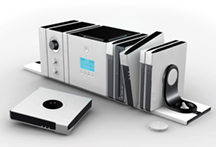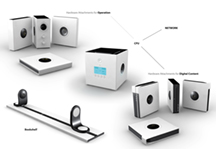
January 12, 2006
New personal computer design wins Microsoft competition
WEST LAFAYETTE, Ind. – Two Purdue University industrial designers won a grand prize at an international competition co-sponsored by Microsoft Corp. for a new personal computer design that may change the way people watch movies, listen to music, play games and read magazines.

|
The concept computer, called Bookshelf, eliminates the most common problems – digital copyrights and inconvenient accessibility – in the multimedia entertainment business today, says graduate student Sungho "Oho" Son.
He teamed with Scott Shim, a professor of visual and performing arts, to design a new personal computer that won the $50,000 Judge's Award at Microsoft's Next Generation Windows PC Design Competition. The competition was sponsored by Microsoft and the Industrial Designers Society of America, and the winners were announced at the 2006 International Consumer Electronics Show in Las Vegas on Jan. 5-8.
"How this computer is used closely resembles the traditional use of a bookshelf," says Son, a second-year graduate student from Seoul, South Korea. "Digital contents are downloaded through subscriptions, then arranged in each hardware attachment, which are provided by the subscription's service. The physical configuration of the unit permits users to visually navigate the categories of content as they do with books on a bookshelf.

|
"Up until now, personal computer designs seemed to be based on the issues of processing speed or performance rather than the user's convenience."
The personal computer physically resembles a bookshelf and functions like a bookshelf as books and magazines – or in this case, hardware – are placed on it. The foundation of the computer is its central processing unit, which is a 7-inch cube. The Bookshelf operates with add-on hard drive attachments that are supplied by digital service providers so they can protect copyrights while still accommodating user convenience and portability. The hardware attachments – containing multiple movies, games, or magazines – will vary in width, but its other dimensions will be the same as the Bookshelf cube. As the hardware attachments are added, the Bookshelf becomes its own multimedia library custom-built by its owner. For example, users can watch movies by connecting to a television or computer monitor.

|
All the components sit on a shelf where they are held in place with latched bookends. This is made possible by the universal design of the hardware attachments, which feature sidelocking mechanisms.
Son realized the need for such a computer while helping a friend with a large digital video disc collection move. Last spring, Son began researching designs and products available on the market, and he even spent time in cafés and libraries to observe laptop users.
"We didn't just want to focus on the aesthetics, because we wanted to create a solid business model," says Shim, adviser and team member for this project. "The basis of this concept is to provide a model that users can personalize and configure as part of their own system in this digital era."
One of the greatest concerns in the computer and digital industries today is copyright, Shim says. Studies show that consumers are more likely to disregard the ownership and copyright of digital contents because such files lack the physical properties of format media such as compact discs (CDs), laser discs (LDs) or digital video discs (DVDs).
"Because of the Bookshelf design, users comprehend the psychological aspect of ownership to secure copyright," Shim says. "It's just like owning a book."
Shim and Son are looking into bringing the computer design to market. The design they submitted to the competition was rendered with Alias Image Studio software.
Microsoft introduced the competition in 2005 in collaboration with the Industrial Designers Society of America and two personal computer manufacturers, Dell and HP, to help celebrate the 20th anniversary of Microsoft Windows and the upcoming release of the next version of the operating system Microsoft Windows Vista. Bookshelf was selected by a team of judges, and a second grand prize was selected by Microsoft Corp. chairman Bill Gates. The sChOOL pack, designed by Prashant Kumar Chandra of New Delhi, India, received the Chairman's Award.
Purdue's industrial design program is part of the Patti and Rusty Rueff Department of Visual and Performing Arts. Purdue industrial design graduates have found jobs in corporations and consulting firms focusing on the design and development of products for manufacturing. Industrial design students also have worked in transportation, commercial and residential equipment, recreation, medical equipment, electronics and exhibits.
Son earned a bachelor's degree in industrial design from Kookmin University in South Korea. Before coming to Purdue, he worked at the Daewoo Electronics Design Center in Seoul and was senior designer at a design consultancy firm for five years.
Son and Shim were colleagues at Daewoo Electronics Design Center, where Shim worked for six years before coming to Purdue in 2003. He earned his bachelor's degree in industrial design from the University of Illinois-Chicago and a master's degree in design development from Ohio State University.
Shim also was part of a team last spring that won the grand prize at the Ninth International Bicycle Design Competition in Taiwan with a new design called SHIFT. The design, which topped 853 entrants from 56 countries to win the $15,000 prize, looks like a tricycle, but as the child gains momentum and learns to balance, the two rear wheels shift inward to merge into one wheel. This causes the balance to gradually shift from the bicycle to the child. SHIFT also was included among the most innovative inventions in 2005 by Time magazine.
Writer: Amy Patterson Neubert, (765) 494-9723, apatterson@purdue.edu
Sources: Scott Shim, (765) 494-3069, ssshim@cla.purdue.edu
Sungho "Oho" Son, son5@purdue.edu
Purdue News Service: (765) 494-2096; purduenews@purdue.edu
Related Web site:
Microsoft Press Pass
PHOTO CAPTION:
Industrial design graduate student Sungho "Oho" Son, from left, and Scott Shim, assistant professor of visual and performing arts, stand beside their personal computer design called Bookshelf that won the $50,000 Judge's Award at Microsoft's Next Generation Windows PC Design Competition. Digital content, such as movies, can be downloaded through subscriptions, then arranged in each hard drive attachment, which is provided by the subscription's service. The physical configuration of the unit permits users to look at the content as they do with books on a bookshelf. (Photo provided by Sungho "Oho" Son)
A publication-quality photo is available at https://www.purdue.edu/uns/images/+2006/shim-computer.jpg
PHOTO CAPTION:
The Bookshelf is a personal computer that physically resembles a bookshelf and functions like a bookshelf as books and magazines – or in this case, hardware – are placed on it. The foundation of the computer is its central processing unit, which is a 7-inch cube. The Bookshelf operates with add-on hard drive attachments that are supplied by digital service providers. (Photo provided by Sungho "Oho" Son)
A publication-quality photo is available at https://www.purdue.edu/uns/images/+2006/shim-computer2.jpg
PHOTO CAPTION:
This image shows how the Bookshelf can be pieced together with hard drive attachments that contain multiple movies, games or magazines. As attachments are added, the Bookshelf becomes its own multimedia library custom built by its owner. (Photo provided by Sungho "Oho" Son)
A publication-quality photo is available at https://www.purdue.edu/uns/images/+2006/shim-computer3.jpg
To the News Service home page